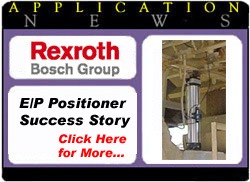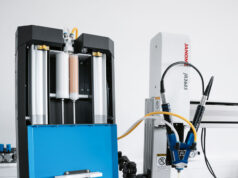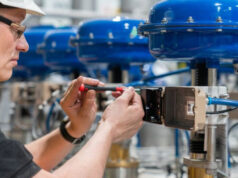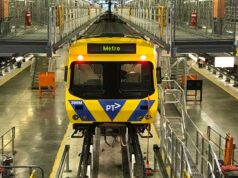 E/P Positioner Success Story
E/P Positioner Success Story
Bosch Rexroth Pneumatics
February 2007
Mixing It Up:
Rexroth Electro-Pneumatic Positioner Helps RMC Pacific Materials Combine Aggregates While Controlling Gates
By Bob Atchison, Bosch Rexroth Pneumatics District Sales Manager and Certified Fluid Power Specialist
Manufacturing five different types of cement to meet various building requirements, RMC Pacific Materials, headquartered in Pleasanton, CA, is a key supplier in the building materials industry. Aggregate (sand and gravel), a main ingredient in concrete, is used in RMC’s ready-mix operation and marketed to other ready-mix concrete producers and manufacturers of products such as concrete block, interlocking pavers and lightweight roofing tiles. These building products have been used in such high-profile projects as the San Francisco Giants’ Pacific Bell Stadium and the Monterey Bay Aquarium.
Recently, with the help of Randy Mull, a professional engineer with Eichleay Engineers, Inc., a Concord, CA-based full-service design and services firm specializing in the life sciences and high-tech markets, distributor Motion Industries and Bob Atchison of the Pneumatics business unit of Bosch Rexroth Corporation, RMC automated its aggregate mixing operations at two of its California plants: RMC Pacific Materials in Pleasanton and Harbor Sand and Gravel in Redwood City. Using Rexroth electro-pneumatic, or E/P, positioners, RMC is now able to monitor and control gate positions and protect its mixing lines from overfeeding in case of power failure or malfunction.
Fail-Safe Solution
The basic process of aggregate mixing begins with mined aggregate which is washed, crushed and segregated into various components according to size. These components are then recombined according to ASTM specifications to create products used in making concrete, asphalt and aggregate. The mixing processes at each of the RMC locations employ Rexroth E/P positioners to open and close the gates that discharge material directly onto conveyor belts, which transport the material to predefined locations within the plants. Depending on the material being produced, from one to four different gates can be opened to blend ingredients.
“This is the first time this type of automation has been used in aggregate mixing,” notes Bosch Rexroth’s Atchison. “Once we tackled the size issue – we needed a five-inch bore, which was a larger unit than we generally offer – the main challenge was the unit had to be ‘fail-safe’ in the extended position.”
At RMC’s Harbor Sand and Gravel plant, the E/P positioner opens and closes a gate to control the amount of material released onto a conveyor to maximize the tonnage being transported without overloading the system. Feedback from a belt scale downstream opens or closes the gate controlled by the E/P positioner to maintain a tons-per-hour flow set by the operator. Once the E/P positioner is given a set point by a PLC, it moves the gate to the given position and then monitors the position, making adjustments as necessary. Feedback information from the E/P positioner is monitored by the PLC and alerts the operator in the event of a malfunction.
“Quality control samples are taken daily, and the results are used to fine-tune positioner settings,” notes Richard “Butch” Kelly, project and resource manager for RMC’s Aggregate Division. “These are then periodically updated to make a more consistent blend, with fewer operator adjustments. Also, less ‘out-of-spec’ material means less re-work and less re-purchasing of unsatisfactory material.”
Tony Fuentes of RMC’s quality control department agrees with Kelly that the automated positioners have improved the reliability of the aggregate products made through the load-out system.
“We have noticed a marked improvement in our operating band, and we have tightened our operating ranges on several products,” says Fuentes. “The new system has taken a lot of the guesswork out of the gate positions, and one of the biggest benefits is that we can make changes with little or no effect to our product or operating parameters. We can also offer custom blends with more accuracy, which is a huge benefit for special projects.”
According to Eichleay’s Mull the E/P positioners replaced existing air cylinders at each aggregate mixing location, making installation easier and less expensive since air was already available. A push-button station was already being used to interface with the existing air cylinders, so it was a relatively simple task to integrate the new cylinders into the system while the plant maintained normal day-to-day operations.
“Without the positioner,” says Mull, “additional I/O slots from the PLC would have been required to open and close solenoids on the cylinder to maintain the set point.”
What’s more, the size of the cylinders was big enough to stop the flow of material when closing, move the gates and control the flow of material. Typically, the actuators default to the retracted position upon signal failure, or stay where last commanded upon total loss of power.
“We needed to reverse this operation because the gate closed only when the cylinder was extended,” explains Atchison. “We couldn’t risk leaving the chute gate even partially open, as the silo could completely empty on a stalled conveyor and create a costly clean-up operation.”
By reversing signal wires and plumbing lines, adjusting command signals accordingly and adding a normally open 3/2 valve, which overrides the pilot pressure to the directional valve that extends the cylinder, the team was able to achieve the desired effect. The system is also equipped with an air reservoir to allow cylinder actuation even after a power failure stops the air compressors.
“The E/P positioner was the only device on the market that could provide feedback on its actual position after it had been told to go to a particular position,” says Mull. “In this way, we could send a signal to the positioner telling it the position we wanted it to go to, and then look at the return date to verify that the gate in fact moved and was in the correct position.”
Power failures occur an average of three to four times per year at the plant. In the past, each time the power failed, the cylinders remained in their last position, as the solenoids were electrically actuated. This allowed the contents of the bunker to spill onto the stopped conveyor belt, burying the belt and requiring several hours of cleanup before the belt could be restarted.
“By developing a fail-safe strategy, the cylinders are set up to fully extend in the event of power failure,” describes Mull. “Upon power failure, any residual air pressure in the lines is used to extend any open cylinders to their fully extended position, thus closing any open gates and eliminating the associated spills and cleanup.”
Atchison noted that E/P positioner technology can be used with any application in which discharge of material onto a conveyor must be metered to accurately monitor flow.
“In addition to being a very cost-effective solution, it can handle very extreme external conditions such as dirt, dust, water or other liquid or solid contamination. The cylinder and valves used in this system are designed to withstand these elements. The control card is the only part of the system that must be in an enclosure, but it doesn’t necessarily need to be located at the cylinder; it can be several feet away and still function as well,” he adds.

The Rexroth E/P positioner provides strokes available in any length, from one inch to 10 inches, or in two-inch increments between 10-inch and 18-inch strokes. Strokes up to 60” can be special ordered (as in this case.) The positioner’s accuracy is +/- .050 inch or one percent full stroke, whichever is greater; and its repeatability is +/- .050 inch. Stroking speeds range from .5 inch/second to 2 inches/second, and operating temperatures range from 41 degrees F to 122 degrees F. The unit’s feedback device is an internally mounted linear potentiometer for applications in which infinite positioning requirements allow electrical analog control signals. The positioner interfaces with a computer, PLC or simple potentiometer (in this case a PLC) and comprises a cylinder with an integral sensor, optimized valving and an electronic controller. The basic concept involves a cylinder with integral feedback potentiometer in conjunction with a controller and matched solenoid valves.
The Pleasanton plant has been using the Rexroth E/P positioner for approximately four years, introducing the positioners in an aggregate blending application about two years ago where units are used to divert the effluent from a rock crusher onto two conveyors.
Since then, it has been bombarded with gravel, sand, dirt and water and harsh air quality, yet the unit has functioned daily with only minimal maintenance required—an important factor in the selection of this technology. In the final project, 25 units were installed at the Pleasanton plant, and the Redwood City facility is currently in test operation with one unit at each plant.
Summarizes Kelly: “Ultimately, the positioners have helped improve the quality and reduce the cost of material being shipped to our customer, which allows RMC to remain very competitive in the marketplace.”
# # #
Sidebar
How to Select an Electro-Pneumatic Positioner
· Determine the amount of force required for the application.
· Determine the available supply pressure.
100 psi nominal or 125 psi max at 5 micron filtration is recommended.
· Note the length of the stroke required.
Stroke lengths are available in any length, from one inch to 10 inches, and two-inch increments between 10-inch and 16-inch strokes.
· Check and note the accuracy and speed requirements.
Accuracy +/- .050 inches or one percent full stroke, whichever is greater. Repeatability +/- .050 inches.
Stroking speed .5 inches/second to two inches/second.
· Determine if meter drive output is desired.
Optional 0-20 ma.
Company Information:
Bosch Rexroth Corp. – Pneumatics
Lexington, KY
www.boschrexroth-us.com
1-800-REXROTH (1-800-739-7684)
info@boschrexroth-us.com
Bosch Rexroth AG, part of the Bosch Group, achieved sales of approximately $5.7 billion (4.6 billion Euro) in 2005 with over 28,200 employees. Under the brand name of Rexroth the company offers all drive and control technologies, from mechanics, hydraulics and pneumatics to electronics and associated service. Over 500,000 customers worldwide utilize Rexroth’s unique technological know-how to implement their innovative and future-oriented systems and machine concepts. The global player, represented in over 80 countries, is an extensive supplier of components and systems for industrial and factory automation and mobile applications. For more information visit www.boschrexroth-us.com.









